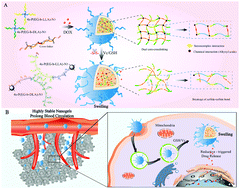Exogenous vitamin C triggered structural changes of redox-activated dual core-crosslinked biodegradable nanogels for boosting the antitumor efficiency†
Abstract
Premature leakage of drugs during blood circulation and slow drug release at the tumor site are two major challenges that nanocarriers have to overcome to achieve successful cancer therapy. Herein, a dual core-crosslinked, redox-sensitive polymeric nanogel (sDL) was constructed by the self-assembly of two star-shaped amphiphilic copolymers (4sP(EG-b-LLA)-N3, 4sP(EG-b-DLA)-N3) in the presence of a redox-sensitive crosslinker (d-ss-Bu), where hydrophilic polyethylene glycol (PEG) was used as the shell and the functional hydrophobic poly(L-lactide) (PLLA) and poly(D-lactide) (PDLA) were used as the dual crosslinked core via stereocomplex formation and chemical interactions. The dual core-crosslinked structure of the nanogels allowed for almost 2-fold enhanced doxorubicin (DOX)-loading capacity, favorable structural stability to restrict the premature leakage of therapeutic drug and smaller particle size to accelerate the internalization efficiency compared to non-crosslinked nanocarriers. Furthermore, exogenous vitamin C (Vc) can trigger the breakage of redox-sensitive bonds to accelerate drug release from nanogels for improved in vitro antitumor efficacy. Notably, in vivo near-infrared imaging showed that the highly stable DOX-loaded sDL efficiently aggregated at the tumor site. Sequential administration of DOX-loaded sDL and Vc exhibited the highest tumor inhibition effect without associated systemic toxicity compared to the corresponding single injection of Vc or DOX-loaded sDL control groups for in vivo studies, indicating that exogenous administration of Vc can synergistically impact the release of DOX from sDL. Therefore, the developed nanogels proved to be promising smart carriers for achieving precise tunable-stability in response to relevant environments and the combination of Vc to activate reduction-sensitive drug delivery is a promising approach to maximize the therapeutic efficacy.



 Please wait while we load your content...
Please wait while we load your content...